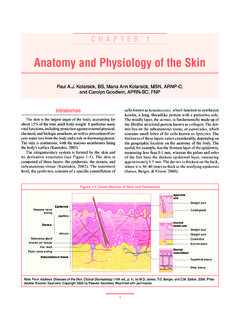Transcription of Cells Vocabulary List & Definitions Term Definition
1 Cells Vocabulary List & Definitions Term Definition Tissue The mass of like Cells in an animal or plant body, esp. as they form a specific organ. Organ In a plant or animal, a specialized structure that performs a particular function, such as the heart. organelle A specialized subunit within a cell that has a specific function, and is usually separately enclosed within its own membrane. Cell membrane (plasma membrane) The thin layer of protein and fat that surrounds the cell. The cell membrane is semipermeable, allowing some substances to pass into the cell and blocking others. Cytoplasm The jellylike material outside the cell nucleus in which the organelles are located.
2 Mitochondrion Spherical to rod-shaped organelles with a double membrane. The inner membrane is infolded many times, forming a series of projections (called cristae). The mitochondrion converts the energy stored in glucose into ATP (adenosine triphosphate) for the cell. Golgi body (Golgi apparatus or Golgi complex) A flattened, layered, sac-like organelle that looks like a stack of pancakes and is located near the nucleus. It produces the membranes that surround the lysosomes. The Golgi body packages proteins and carbohydrates into membrane-bound vesicles for "export" from the cell. Lysosome (cell vesicles) Spherical organelles surrounded by a membrane; they contain digestive enzymes.
3 This is where the digestion of cell nutrients takes place. Nuclear membrane The membrane that surrounds the nucleus. Nucleus Spherical body containing many organelles, including the nucleolus. The nucleus controls many of the functions of the cell (by controlling protein synthesis) and contains DNA (in chromosomes). The nucleus is surrounded by the nuclear membrane Nucleolus An organelle within the nucleus - it is where ribosomal RNA is produced. Some Cells have more than one nucleolus. Chromosome One of the tiny, threadlike, DNA-containing bodies found in the cell nuclei of all plants and animals, responsible for transmitting hereditary characteristics. Ribosome Small organelles composed of RNA-rich cytoplasmic granules that are sites of protein synthesis.
4 Rough endoplasmic reticulum (rough ER) A vast system of interconnected, membranous, infolded and convoluted sacks that are located in the cell's cytoplasm (the ER is continuous with the outer nuclear membrane). Rough ER is covered with ribosomes that give it a rough appearance. Rough ER transports materials through the cell and produces proteins in sacks called cisternae (which are sent to the Golgi body, or inserted into the cell membrane). Smooth endoplasmic reticulum (smooth ER) A vast system of interconnected, membranous, infolded and convoluted tubes that are located in the cell's cytoplasm (the ER is continuous with the outer nuclear membrane). The space within the ER is called the ER lumen.
5 Smooth ER transports materials through the cell. It contains enzymes and produces and digests lipids (fats) and membrane proteins; smooth ER buds off from rough ER, moving the newly-made proteins and lipids to the Golgi body, lysosomes, and membranes Cells Vocabulary List & Definitions Centrosome (microtubule organizing center) A small body located near the nucleus - it has a dense center and radiating tubules. The centrosome is where microtubules are made. During cell division (mitosis), the centrosome divides and the two parts move to opposite sides of the dividing cell. The centriole is the dense center of the centrosome (plant Cells do not have centrioles).
6 Vacuole (animal) Fluid-filled, membrane-surrounded cavities inside a cell. The vacuole fills with food being digested and waste material that is on its way out of the cell. Vacuole (plant) A large, membrane-bound space within a plant cell that is filled with fluid. Most plant Cells have a single vacuole that takes up much of the cell. It helps maintain the shape of the cell. Cell wall (plant) A thick, rigid membrane that surrounds a plant cell. This layer of cellulose fiber gives the cell most of its support and structure. The cell wall also bonds with other cell walls to form the structure of the plant. Chlorophyll (plant) The green pigment in the leaves and stems of plants that is necessary for the production of plant food by photosynthesis.
7 Chloroplast (plant) An elongated or disc-shaped organelle containing chlorophyll. Photosynthesis (in which energy from sunlight is converted into chemical energy - food) takes place in the chloroplasts.












